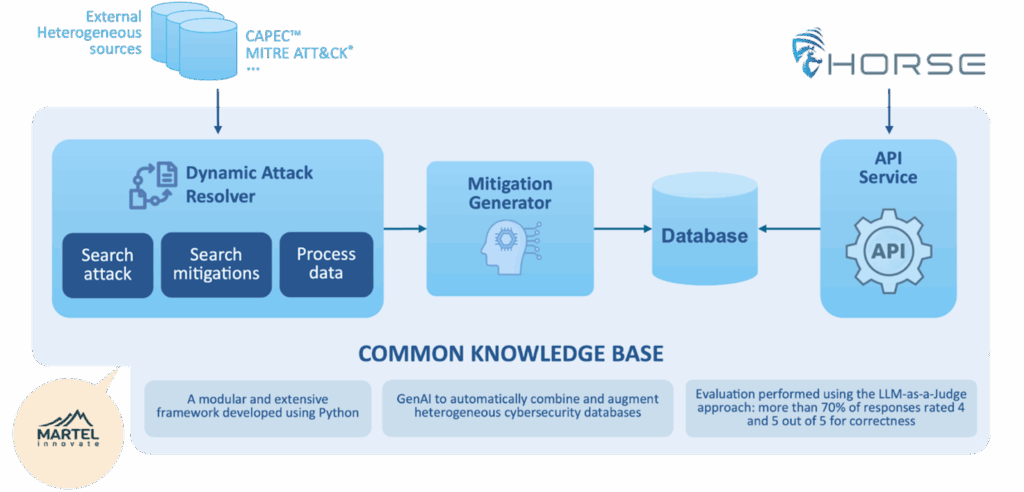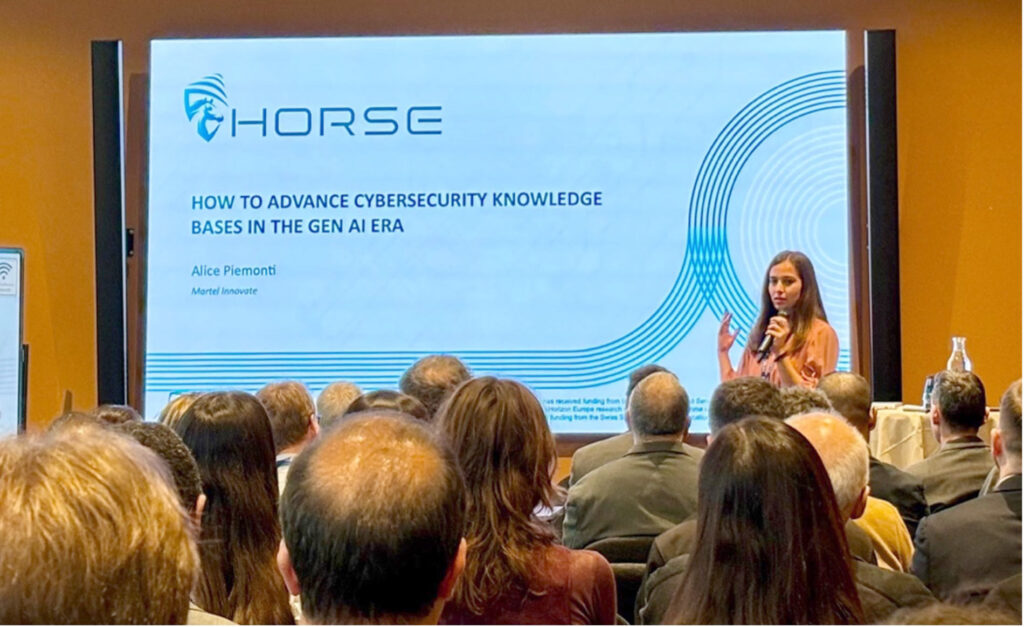HORSE at EBDVF 2025: Pioneering Generative AI for Cybersecurity Knowledge Bases
HORSE Project Lands in Copenhagen
From 12 to 14 November 2025, the HORSE project took centre stage at EBDVF 2025 in Copenhagen, one of Europe’s key events shaping the future of data, AI and digital transformation, organised by the Big Data Value Association (BDVA). Martel Innovate represented the project with a dedicated contribution in the Generative AI track, bringing HORSE’s vision into a discussion on how GenAI can reshape cybersecurity knowledge bases.
The event opened with a full morning of inspiring keynotes and strategic panels, setting the tone for three intense days. In the afternoon, parallel sessions kicked off, including “Generative AI and Agents for European Industry and Public Sector Transformation”, where Martel presented HORSE’s latest outcomes and its role in advancing secure, trustworthy AI for cybersecurity in Europe.
Generative AI and Agents for European Industry and Public Sector Transformation
The session brought together a diverse lineup of companies demonstrating how generative AI is reshaping products and workflows across industries. From agentic AI systems used by SESTEK to automate customer service interactions, to AI-generated incident reporting tools presented by NEC. The talks highlighted how organisations are experimenting with autonomous, LLM-driven solutions. JOT Internet Media focused on creative applications, using GenAI to produce marketing images and videos at scale, dramatically cutting production time and costs, though it was clear that the field still has room to mature before reaching its full potential.
Within this context, Alice Piemonti (Martel Innovate) took the stage to present one of the core components of the HORSE platform: the Common Knowledge Base (CKB). This intelligent cybersecurity database leverages state-of-the-art generative AI to enrich existing cybersecurity frameworks such as CAPEC and MITRE ATT&CK, providing up-to-date attack-mitigation knowledge that evolves at the speed of emerging threats.
The HORSE Common Knowledge Base: an Intelligent Cybersecurity Database

Fig.1 The modular architecture of the Common Knowledge Base developed by Martel Innovate within the HORSE platform.
At the heart of the HORSE platform lies the Common Knowledge Base (CKB) — a key component designed to act as a unified, intelligent repository mapping cyberattacks to effective mitigation actions. Developed through a modular Python architecture, the CKB ensures smooth interoperability designed to operate not only in the HORSE ecosystem but also in other cybersecurity platforms that may benefit from an enriched source of knowledge.
The workflow begins with the Dynamic Attack Resolver, a module that automatically connects to established cybersecurity frameworks such as CAPEC and MITRE ATT&CK. It extracts and merges relevant information, forming the foundation of the initial attack-mitigation dataset.
From there, the process is enhanced by the Mitigation Generator, where multiple Large Language Models (LLMs) are used to expand the database. These models generate new mitigation strategies and even propose execution priorities, transforming a static dataset into a dynamic, evolving knowledge system.
Given the sensitivity and high stakes of cybersecurity, evaluation is a critical part of the pipeline. The CKB integrates both the LLM-as-a-Judge technique and Human-in-the-Loop validation, ensuring that every generated mitigation is correctly evaluated. Once validated, the final outputs are stored in the final Database and made accessible through a secure API service, enabling seamless integration with external tools, in this case, the HORSE’s other security components.
As highlighted in the talk, the key message is clear:
“Generative AI is not yet ready to operate fully autonomously. Human expertise remains essential to guarantee trust and accuracy. But this research lays the groundwork for the autonomous systems of tomorrow.” — Alice Piemonti, AI Engineer at Martel Innovate.
Panel Discussion
Following the presentations, the session transitioned into a lively and thought-provoking panel discussion. Kristina Knaving (RISE) led the conversation with energy, challenging the speakers with questions that cut straight to the core of Europe’s AI landscape. One of the most striking topics she raised was: “How dependent is Europe on non-EU technologies when it comes to AI assets, and what must we do to strengthen sovereignty and protect citizens’ privacy?”

The panelists tackled these questions with clarity and confidence, offering diverse perspectives grounded in real-world experience. There was a shared acknowledgement that Europe is still heavily reliant on non-EU technologies, especially when it comes to LLMs, the most advanced models are currently developed and owned by companies in the US or China. Some participants argued that this dependency is not inherently negative, suggesting that using external AI models does not automatically undermine privacy or competitiveness, and that Europe holds strong positions in other strategic areas. Others firmly disagreed, stressing that technological sovereignty must be a priority, and that Europe should invest in AI factories, high-performance data centres, chip manufacturing, and compliant-by-design AI systems aligned with regulations like the AI Act and GDPR.
Their exchange quickly sparked a broader dialogue with the audience, turning the room into an open, constructive discussion about Europe’s strategic capabilities, risks, and opportunities of genAI solutions. The result was a rich and honest discussion.
Final Remarks: Moving Forward with Momentum
EBDVF stands among Europe’s most awaited events in the fields of AI and data, and having the opportunity to present HORSE’s advancements in such a prominent setting is a significant milestone for the project. Showcasing the progress of the Common Knowledge Base component not only reinforces the value of HORSE’s research but also highlights the project’s role in shaping the future of trustworthy, AI-driven cybersecurity.
This momentum will continue as we work toward the final release of the HORSE platform, including demonstrations, evaluations, and the integration of all project components. This participation at EBDVF was a concrete example of the innovation and tangible impact in delivering and advancing AI-driven cybersecurity.
We look ahead with excitement and commitment, ready to share more results and push the boundaries of secure, intelligent cybersecurity for Europe.

